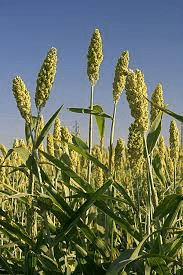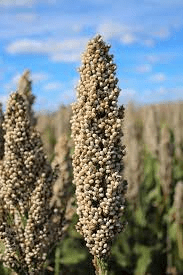The guinea corn palea is a significant structure in the sorghum plant (Sorghum bicolor), located within the spikelet alongside the lemma. The palea, also known as the palea bract, plays an essential role in protecting and supporting the florets and seeds during their development.
The palea is a thin, membranous, and often delicate structure that forms part of the protective layer surrounding the developing seed. It is positioned inside the spikelet, adjacent to the lemma, and helps enclose the florets, which are the reproductive units of the sorghum plant. Typically, each spikelet contains one palea for each floret, contributing to the overall organization of the spikelet.
Structurally, the palea is composed of a single layer of cells and lacks the toughness of the lemma. Its primary function is to provide additional protection and support to the florets, complementing the role of the lemma. The palea helps shield the reproductive organs from physical damage, pests, and environmental factors, ensuring that the seeds develop under optimal conditions.
During the grain maturation process, the palea plays a role in maintaining the integrity of the developing seed. It helps to protect the florets from moisture and pathogens, reducing the risk of spoilage and ensuring the seeds’ viability. This protective function is crucial for the successful development of high-quality grains that are suitable for harvesting and consumption.
In terms of agricultural practices, the palea, along with other parts of the spikelet, is typically removed during the processing of sorghum grains. However, like other plant residues, the palea can be utilized in various ways. For example, it can be included in animal feed or used in compost and mulch. The fibrous nature of the palea makes it a valuable component for enhancing soil fertility and providing roughage for livestock.
The palea also has implications for sorghum breeding and variety selection. Variations in the size, shape, and texture of the palea can influence the overall structure and appearance of the spikelet. These traits can be important for identifying and selecting sorghum varieties based on specific criteria such as yield, disease resistance, and grain quality. Researchers may focus on the palea’s characteristics to develop varieties with improved protective features and enhanced productivity.
Ongoing research into the palea aims to better understand its role in seed protection and development. Scientists study the genetic and physiological aspects of the palea to explore ways to improve its functionality and contribution to overall plant performance. Advances in this research support the development of sorghum varieties that can better withstand environmental stresses and diseases.
The guinea corn palea is a vital component of the sorghum spikelet, providing crucial protection and support to the developing florets and seeds. Its role in shielding the seeds from environmental factors and contributing to the plant’s reproductive success underscores its importance in agriculture. The palea’s characteristics and potential uses in various applications highlight its significance in sustainable farming practices and sorghum breeding.
The Economic Importance and Uses of Guinea Corn Palea

1. Grain Protection: The palea is one of the protective structures covering the guinea corn grain, helping to shield it from pests and environmental damage.
2. Animal Feed: The palea, along with other parts of the grain, can be used as feed for livestock, providing additional nutrients.
3. Composting: Paleas are often composted to create organic matter that enriches soil health.
4. Biofuel Production: Paleas can be processed into biofuels, such as biogas, through anaerobic digestion.
5. Mulching: Paleas are used as mulch to retain soil moisture and suppress weed growth.
6. Crafts and Decorations: Paleas can be used in making crafts and decorative items due to their texture and appearance.
7. Soil Erosion Control: Palea residues can be used in soil erosion control measures to stabilize soil and prevent runoff.
8. Organic Pesticides: Extracts from paleas can be used in the preparation of organic pesticides.
9. Bedding Material: Chopped paleas can be used as bedding material for animals, providing comfort and absorbency.
10. Fertilizer: Decomposed paleas are used as a natural fertilizer to enhance soil fertility.
11. Bio-composites: Paleas are used in producing bio-composites, which are materials made from natural fibers and resins.
12. Traditional Medicine: In some cultures, paleas are used in traditional medicine for their purported benefits.
13. Paper Production: The fibers from paleas can be processed into paper, including craft paper.
14. Mushroom Substrate: Paleas can be used as a substrate for cultivating mushrooms.
15. Erosion Barriers: Paleas are used to create barriers that help control soil erosion.
16. Animal Bedding: Palea provides a natural, absorbent material for use as bedding for livestock.
17. Bio-plastics: Paleas can be used in the production of biodegradable plastics.
18. Research Material: Paleas are utilized in research to explore new uses and improve agricultural practices.
Read Also: The Most Lucrative between Production of Fish Fingerlings or Raising them to Table Size
The Products and By-products That Can Be Derived From Guinea Corn Palea

1. Animal Feed: Chopped paleas are used as feed for livestock.
2. Compost: Paleas are composted to produce nutrient-rich organic fertilizer.
3. Biogas: Paleas can be processed into biogas through anaerobic digestion.
4. Mulch: Paleas are used as mulch to retain soil moisture and suppress weeds.
5. Craft Items: Paleas are used in crafting decorative items.
6. Packaging Material: Paleas are used as traditional packaging material.
7. Soil Erosion Control: Paleas are used to create barriers for controlling soil erosion.
8. Organic Pesticides: Extracts from paleas are used to make organic pesticides.
9. Bedding: Chopped paleas are used as bedding for animals.
10. Fertilizer: Decomposed paleas are used as a natural fertilizer.
11. Bio-composites: Paleas are used in making bio-composites for various applications.
12. Craft Paper: Fibers from paleas are processed into craft paper.
13. Mushroom Substrate: Paleas are used as a substrate for mushroom cultivation.
14. Erosion Barriers: Paleas are used in creating barriers to prevent soil erosion.
15. Bio-plastics: Paleas are processed into biodegradable plastics.
16. Traditional Medicines: Extracts from paleas are used in traditional medicinal preparations.
17. Research Materials: Paleas are used in agricultural research for developing new practices and products.
Read Also: The Ultimate Step-by-Step Guide to Vegetable Gardening
Frequently Asked Questions (FAQ’s) About Guinea Corn Palea

1. What is a guinea corn palea?
A guinea corn palea is a protective structure that covers the grain of the guinea corn plant.
2. How are guinea corn paleas used in agriculture?
They are used in animal feed, composting, mulching, and soil erosion control, among other applications.
3. Can guinea corn paleas be used for biofuel?
Yes, paleas can be processed into biogas through anaerobic digestion.
4. What products can be made from guinea corn paleas?
Products include animal feed, compost, mulch, crafts, and biodegradable plastics.
5. Are guinea corn paleas used in traditional medicine?
Yes, in some cultures, paleas are used in traditional medicinal practices.
6. How do guinea corn paleas contribute to soil health?
They are used as compost and mulch to improve soil fertility and moisture.
7. Can guinea corn paleas be used in mushroom cultivation?
Yes, paleas can be used as a substrate for growing mushrooms.
8. What is the economic importance of guinea corn paleas?
They contribute to various industries, including agriculture, crafts, and biofuel production.
9. How are guinea corn paleas used in erosion control?
Paleas are used to create barriers that help prevent soil erosion.
10. Are guinea corn paleas biodegradable?
Yes, paleas are biodegradable and used in composting and other applications.
Read Also: What You Need to Know About Osteospermum

